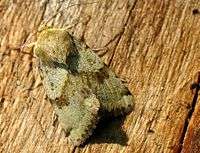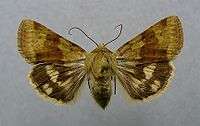Heliothis viriplaca
Heliothis viriplaca, the marbled clover, is a moth of the family Noctuoidea. It is found in Europe and across the Palearctic to Central Asia then to Japan , Korea and Sakhalin . In the south, it penetrates to Kashmir and Myanmar . As a migratory moth , it also reaches areas in northern Fennoscandia in some years . North of the Alps , both indigenous and immigrant individuals occur in certain areas. The heat-loving species occurs mainly on dry grasslands, fallow land, heathlands and sunny slopes and slopes and the edges of sand and gravel pits.
| Heliothis viriplaca | |
|---|---|
 | |
 | |
| Scientific classification | |
| Kingdom: | |
| Phylum: | |
| Class: | |
| Order: | |
| Family: | |
| Genus: | |
| Species: | H. viriplaca |
| Binomial name | |
| Heliothis viriplaca (Hufnagel, 1766) | |
| Synonyms | |
| |
The wingspan is 25–30 mm. Meyrick describes it thus- Forewings greyish-ochreous, slightly greenish -tinged, paler before and beyond reniform; first and second lines indistinct ; median shade rather dark fuscous, confluent with large dark fuscous reniform ; subterminal line rather paler, preceded by a darker or fuscous fascia, darkest at extremities. Hindwings ochreous-whitish, towards base suffused with blackish ; a large discal spot, and terminal band including an ochreous-whitish spot blackish.Larva green to purplish-brown ; dorsal line darker-edged ; subdorsal whitish, dark-edged beneath ; spiracular green or yellowish ; subspiracular white ; head green, pink, or yellowish, brown -speckled. [1]
The moth flies in two to three generations from May to August. .
The larvae feed on species from the genera Crepis, Trifolium, Silene, Ononis and Centaurea.
Notes
- ^ The flight season refers to Belgium and the Netherlands. This may vary in other parts of the range.
References
- Meyrick, E., 1895 A Handbook of British Lepidoptera MacMillan, London pdf
